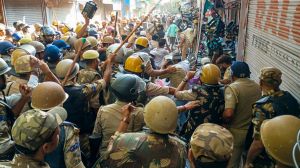Between the City and the Town
Babu XavierBabu Xavier celebrates his ‘bold and beautiful decision’ to stay in Kovalam, a small town in Kerala, with his family. T...

Babu Xavier
Babu Xavier celebrates his ‘bold and beautiful decision’ to stay in Kovalam, a small town in Kerala, with his family. The city is a remote entity in his art — the studio opens out to the vibrant colours of the coast and the timeless quality of a coastal town.
Mumbai is his lucky charm though, where a chance meeting with gallery owner Kali Pundole gave him his first solo show and a place where he has gathered a enviable share of patrons, the biggest of whom is M F Husain. ‘‘Mumbai is only an e-mail away. Physical location hardly matters in these times, what with the IT boom, the print media and news-based programmes on TV. I can easily remain connected,’’he says. He firmly believes that ‘‘art has more cosmopolitan roles to act. What matters is the qualitative transformation from the local to the global dimensions.’’
Xavier’s location naturally allows him to set his own pace of working, which though hardly languid is not the same as that dictated by a city. ‘‘While the access to information is almost same. I would have reservations about the quality of work. The city’s pace and pressure makes it difficult to see things in the right perspective,’’ he feels.
It is about standing alone in the confused, chaotic, cosmopolitan landscape of Indian art. ‘‘It makes me proud and a little arrogant that I can straddle both worlds,’’says Xavier.
Jitish Kallat
For Mumbai-based Jitish Kallat, it has been a life and an art totally rooted in the city. ‘‘I’ve always been engaged with birth, death, survival and mortality as broad themes of my work,’’says Kallat. While his earlier works were autobiographical, the city has figured more directly in his work since 1999. ‘‘It is here that the theatre of survival is played out in full breadth,’’ he exclaims, dramatically.
‘‘I’m so thankful that I live here. The daily grind in the city is a catalyst that squeezes the best out of me — physically, intellectually and spiritually,’’ he adds. It also means juggling his time between the studio and attending various art/social-dos that are so intrinsic to the Mumbai glitterati circuit. Kallat doesn’t think that these must-attends have come in the way of his work. Quite the contrary, the activities allow him to ‘‘absorb endless energy’’, that can be recycled in his art practice.
In the span of his career, he has witnessed the mushrooming of many new galleries and a crop of enthusiastic collectors, who he feels could be better informed. ‘‘There are teething problems. But I think the dictum ‘more is better’ that is the trend in the art world these days needs to be replaced with a new one — ‘more of better’,’’he adds.
THEY come to him on the local train, as he makes his way to the studio that he shares with his wife — the neglected walls, the anonymous faces, the collective angst of a sprawling metropolis. And they appear on his canvas, like distorted memories, time and again.
For Mumbai-based Jitish Kallat, it has been a life and an art totally rooted in the city. ‘‘I’ve always been engaged with birth, death, survival and mortality as broad themes of my work,’’says Kallat. While his earlier works were autobiographical, the city has figured more directly in his work since 1999. ‘‘It is here that the theatre of survival is played out in full breadth,’’ he exclaims, dramatically.
‘‘I’m so thankful that I live here. The daily grind in the city is a catalyst that squeezes the best out of me — physically, intellectually and spiritually,’’ he adds. It also means juggling his time between the studio and attending various art/social-dos that are so intrinsic to the Mumbai glitterati circuit. Kallat doesn’t think that these must-attends have come in the way of his work. Quite the contrary, the activities allow him to ‘‘absorb endless energy’’, that can be recycled in his art practice.
In the span of his career, he has witnessed the mushrooming of many new galleries and a crop of enthusiastic collectors, who he feels could be better informed. ‘‘There are teething problems. But I think the dictum ‘more is better’ that is the trend in the art world these days needs to be replaced with a new one — ‘more of better’,’’he adds.







- 01
- 02
- 03
- 04
- 05
























